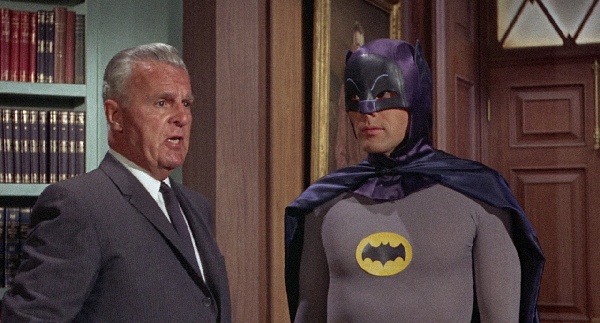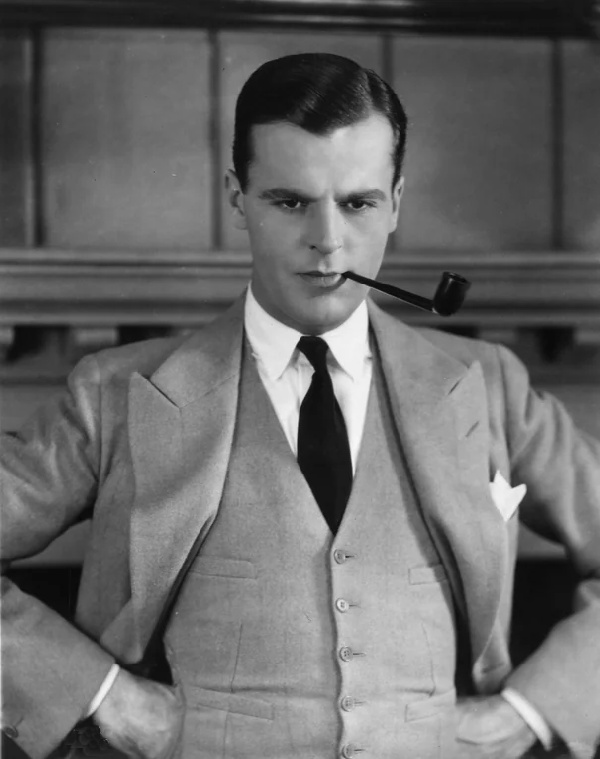Another article about an illustrator’s model; this time it’s actor Neil Hamilton, probably best remembered for his role as Commissioner Gordon in the 1960s TV series Batman starring Adam West.

The Days When I “Posed”
Recollections of Leyendecker, Brown, Underwood and other Famous Artists – And $6 a Day.
By Neil Hamilton
THERE was one time when I earned my living posing for artists in New York. The first one I ever worked for was Joe Leyendecker. I met him while I was doing extra work at the old Biograph studio up on 174th Street, in a picture which I remember had something to do with Roosevelt’s life. I think the director was Bill Nigh.
On the set one day I met a strange man with a long beard. I thought at first he might be a Smith Brother. But after hearing the story of his life I learned he was once a well known photographer. Through a series of unfortunate circumstances he had lost his position, money, wife, everything, and was forced to do extra work. He told me I had a good head to draw and suggested if I wanted to make some money I ought to go around and see some artists.
Up to this time I hadn’t even known that artists used models. I thought they just sat down and drew. I was given a letter to Joe Leyendecker, who was then located in the Beaux Arts Building at the corner of 40th Street and Sixth Avenue.
I went to see him with something of fear and trepidation. I had no idea of what manner of man I was to meet. But I certainly was not prepared for the very mild-mannered, extremely courteous and beautifully turned out Mr. Leyendecker. His studio was beautiful. Almost palatial. I was met by his secretary, Ted Beach, the original Arrow Collar man and an associate of Mr. Leyendecker for some thirty years.
I sat down, while he sketched me for the rest of the afternoon. At the end of the day he handed me a check for six dollars. I later did some Arrow Collar posing for him and a number of Saturday Evening Post Covers. One of these, the original of the Post cover for Thanksgiving, 1918, now hangs in my home.

Through Mr. Leyendecker I met his brother, a commercial artist in New Rochelle, and Coles Phillips. This latter artist then arranged for me to meet Norman Rockwell. It was through this gracious method of one artist sending me to another that I came to know and work for, over a period of three years, some of the finest painters in America.
The pay at that time was six dollars a day. The hours were from nine to five. The work was easy, the conditions and surroundings always very pleasant. The men were invariably amusing, and hard working. In all the years I worked as a model, incidentally, I never once glimpsed anything of the unconventional atmosphere which, according to public belief, pervades an artist’s studio.
The late Clarence Underwood, famous for his Underwood Girl and for water colors, was the only artist I knew to fit the popular picture of what an artist should be like. Shaggy hair, what there was of it. Baggy trousers. A very liberal and extremely gifted man. He was also very excitable.
The first time I ever worked for him he required me to sit on the floor, legs crossed, propped up on one arm and holding a book with the other. Ordinarily a model would pose for three-quarters of an hour and then rest for ten or fifteen minutes. But not with Mr. Underwood. Once a pose was made, you sat there until the picture was finished. I had not been told beforehand of this eccentricity, so, after two hours in the difficult position, I suggested that I get up and stretch my legs. He cautioned me to sit there a few minutes more while he finished the correct shading and shadows. But my body was so numb that suddenly, without notice, the arm on which I was propping myself gave way and I sprawled on the floor. I felt the sensations of pins and needles all over my body.
Mr. Underwood had only a few more minutes to work on the picture and he was so infuriated over my disturbing the pose that he threw his palette and brushes at me. But in a few moments he had calmed down and apologized for his display of temper.
I remember he would become so interested in his painting that instead of wiping the color off his brushes before taking on a new one, he would rub it off on his shirt, or suck it off.
The Underwood studio was on 56th Street, and often for weeks at a time he would allow me to sleep in the studio in order to save room rent. It was typically an old artist’s studio, with half completed pictures and models in clay, debris scattered everywhere, dust and cobwebs. But it was a welcome home for me.
May Wilson Preston and her husband shared the same studio down in the Village. He would work in one corner and she in another. They were extremely well known for their Saturday Evening Post illustrations. I liked working for them because their butler made the most delicious muffins I ever tasted!
James Montgomery Flagg was by far the most fastidious man among the painters. As I recall him, he was always dressed as though he were going for a stroll up Fifth Avenue. I had a strange experience with him. I had met him through Arthur William Brown, one of the few men who photographs his models and then draws from the photographs, his theory being that a model can strike an action pose and hold it long enough for a photograph whereas he would not be able to hold it through long posing periods.
Mr. Flagg engaged me three days a week at five dollars a morning, whether I worked or not. This I thought swell. I worked for him a long time, doing young men, old men, and all his male characters. He cautioned me one day not to go out of town for the next three weeks, since he was using me as the central character in illustrations he was making for a serial magazine story.
The very next day after this conversation, I succeeded in getting my first stage engagement, with De Wolf Hopper in “The Better Ole.” It meant that I would have to leave at once for Birmingham, Ala. When I told Mr. Flagg I was leaving town I recall he was extremely provoked. He told me to get out and stay out, and that I was an extremely ungrateful young man.

It was this incident which made me determine to break away from posing as an occupation. I realized I was getting nowhere, either professionally or financially. Since I had been trying to get on the stage for a long time without any success I decided definitely to give tip posing and devote any talent I had to the theater. However, there were many times afterward when I returned to New York that I was glad to pick up a few dollars posing.
I did a great deal of photographic posing for Mr. and Mrs. Joel Fader. Among those whom I met in the photographic studios those days were May McEvoy, Edna Murphy, Alan Simpson, Kathryn Carver, all unknown at the time except as models. It was for the Faders that I started posing for the Stetson hat ads.
Posing for photographers was pleasant work, as it required only a few minutes to make a picture and the model received five dollars. Let’s suppose that in the morning you did a Stetson hat and a Munsingwear underwear ad, receiving five dollars for each of them. Then, in the afternoon, if you were fortunate, you could go to Underwood and Underwood, Winemiller and Miller, Lejaren Hiller, or others, and do a candy box cover and an Interwoven sox ad. Or maybe stand around a bathtub. That way you would pick up another five or ten dollars.
In addition to the painters I have already mentioned, I worked for and knew well—Will Grefe, whose drawing of the Mulsified Oil ads were famous. You may remember it was a picture of a beautiful girl with long hair falling down her back, wearing a dainty negligee. The model for that picture was Billie Dove. Harry Morse Myers, whose father was the inventor of the Morse code; Orson Lowell, Charles Dana Gibson, creator of the Gibson Girl; Jack Sheridan, Howard Chandler Christy, Balbridge, well known for his drawings of the Orient; Benda, famed for his masks; Harrison Fisher, C. D. Mitchell, Emil Fuchs, Gruger. My work as a model brought me the acquaintanceship of them all.

Had it not been for the extreme generosity of Arthur William Brown just after my marriage, we might have gone hungry for a few days. He generously loaned me one hundred dollars to tide me over until my D. W. Griffith contract started.
Working for artists gave me an intense desire to some day do a little painting myself. Unfortunately, I cannot even draw a straight line. Many friendships were formed then, though, which have lasted through the years, and I always look these people up when I go to New York.
I can recall only one time when I actually “passed out” through the want of food. The artist was a young fellow, I cannot recall his name, who was new in the field. He was married and lived near Van Cortlandt Park. He was too poor to afford a studio and did his painting in his tiny living room, with his three children on the floor and drying diapers scattered around. I borrowed a nickel for the subway, from my landlady, to get there. After posing all morning leaning against the doorway, which in the picture became the edge of a cliff, I suddenly felt very dizzy and slumped to the floor unconscious. When I came to and told the painter and his wife that I hadn’t had anything to eat for two days, they immediately fed me. But he never did call me back to model for him, probably figuring starving models and struggling artists do not belong together.